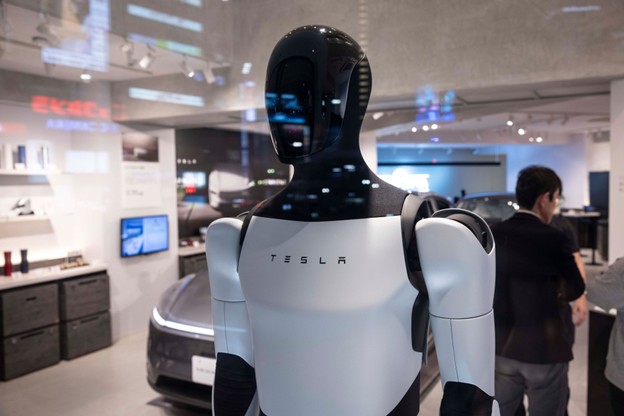BLOG

AI Coming to a Job Near You
AI has exploded onto the scene, led by supercomputing chips from Nvidia (NVDA). Initially, CEOs and CTOs (Chief Technology Officer) were evaluating the potential of this new, highly advanced self-learning technology. When introduced, the application of AI was limited to basic business functionality, primarily with phone systems. In 2022, Tesla incorporated robots in their manufacturing plants that look and function like those in the movie iRobot with Will Smith.

However, consumers are noticing changes in their business experiences as AI is being adopted in many applications. Unfortunately, some businesses view the customer experience as a process to manage efficiently and quickly with the highest profit margin. Prior to AI and advanced technology, a business strategy to increase profit was a process of increasing scale by expanding the company and sales, which created opportunities to reduce costs per transaction.
However, CEOs are willing to determine the tolerance of their customers by altering the customer experience with AI technology and limiting interactions with their employees. McDonald's was an early frontrunner of this experiment by replacing people at the counter with kiosks in the lobby. Customers entered McDonald's with a surprisingly different experience of ordering on a large computer screen instead of at the counter with a staff member. The computer program constantly pressures the customers throughout the food selection process to buy more with suggestions for other options for their meal. If a waitress or waiter peppered you with options while trying to explain what you want, a complaint might be sent to the manager. However, who is there to complain about an irritating computer ordering program? The company’s database tracks your previous orders, and on your next visit, with the use of algorithms and AI, the program can offer you options with a calculated high probability you will select. Restaurants in airports also replaced friendly hostesses with a QR code printed on the table. By scanning the QR code, you can access the menu along with a pay app with a tip option. No welcoming staff, no menus on the table, or a hostess bringing water and suggesting the special of the day. CEOs evidently saw all this extra human interaction in their stores and restaurants as superfluous costs that could be replaced with cheaper technology, causing mild customer dissatisfaction and no change in revenue. After all, where else can captured travelers locked into a secure airport go to get food?
This summer, my family and I traveled to Hawaii, flying United Airlines round-trip. Our group consisted of 17 people, with 10 kids ranging from 3 to 18 and seven adults. I am a million-mile Gold Member with United and have a direct line to the Gold Member help desk that is answered by an individual. This service is very helpful when flights are cancelled or when I need special assistance with my travels. For years, when I called this line, it was answered with a friendly recording stating, “Welcome Anton, are you calling about your trip…”.
Unfortunately, our return flight from Hawaii, scheduled for 7:00 am departure, was cancelled the night before due to “mechanical issues” (what seems to be a more regular occurrence). When I called the very reliable United Gold phone line, I heard a new recording. The recording didn’t welcome me or state my name. What the computer did offer were several options that did not apply to our situation and, most alarmingly, no option to reach a customer service individual. Our dilemma was that the assigned seating on our new red-eye flight had scattered us all around the plane, with no two people sitting together and no adults next to the kids. The newly assigned flight, sent without any input from me, departed at 9:00 pm and arrived in Denver at 6:45 am with a three-hour layover before the final two-hour flight to San Antonio. After more than an hour calling all the available United phone numbers I knew, I finally reached a United travel agent who took another hour organizing our seating, so all the younger kids sat next to an adult. The process was a nightmare, only topped by the horrible red-eye flight home.
In the past, CEOs were discreet with potential staff layoffs and changing their customer experiences as investors viewed this as a precursor to declining revenue and profits. That started to change in 2023. A February 4, 2023, Wall Street Journal article titled "What CEOs Are Saying: 2023 ‘Is the Year of Efficiency’; Leaders from Meta, Apple, Ford and other companies talk about business and consumer spending, AI and hiring plans”. Throughout the article, CEOs used the phrase “efficiencies” as the new code word for labor downsizing, replacing high-cost labor with technology, and stating that the change will not sacrifice customer service.
Then on April 23, 2023, a Wall Street Journal article titled "The Boss Wants to Make You More Efficient; The time-consuming and pointless tasks companies can eliminate to boost our productivity… and save money.” The premise of this article was how technology will help employees be more efficient with their daily tasks and will ultimately improve their productivity.
However, the next evolution that you probably already guessed is that AI companies can now be more efficient without you. A June 18, 2025, Wall Street Journal article titled, “The Biggest Companies Across America Are Cutting Their Workforces; It isn’t just Amazon. There’s a growing belief that having too many employees will slow a company down—and that anyone still on the payroll could be working harder.”
This alarming article identifies how CEOs are reshaping their companies and the employee labor force. In the article, it stated,
“Corporate America is convinced: Fewer employees mean faster growth. U.S. public companies have reduced their white-collar workforces by a collective 3.5% over the past three years, according to employment data provider Live Data Technologies. Over the past decade, one in five companies in the S&P 500 have shrunk. The cuts go beyond typical cost-trimming and speak to a broader shift in philosophy [emphasis added]. Adding talent, once a sign of surging sales and confidence in the future, now means leaders must be doing something wrong. “
CEOs are now celebrating during earnings calls the ability to function with fewer staff, who are being replaced with AI technology. Yesterday’s Wall Street Journal article titled, “CEOs Are Shrinking Their Workforces—and They Couldn’t Be Prouder; Bosses aren’t just unapologetic about staff cuts. Many are touting shrinking headcounts as accomplishments in the AI era.”
According to Live Data Technologies referenced in this article, the decline in headcount is not limited to staff and middle management. For the past 4 years, the board of directors of public companies has been reducing their executives and managers at a faster rate than lower-level employees, as illustrated by the chart below.

What Does This Mean to Me?
Many companies will be embracing AI and technology to replace high-cost human labor. The hope and goal are to improve customer experience, lower costs, and increase revenue. However, if any one of these objectives is not met, and especially if customers start to complain or worse leave, then CEOs will hopefully evaluate their reliance on technology.
The larger national companies will be the leaders in this transition and may drive their customers to smaller, more personal businesses. The question will be how much more consumers pay for better service or the opportunity to work with human personnel? National companies have felt the sting of revolting customers due to poor business decisions, including Budweiser and Target. The S&P 600 Small Cap index has been trailing the S&P 500 large cap since March 2022 due to the larger companies' market dominance and cost leverage.

However, large companies overextend their reliance on AI and technology, and consumers may move their business to smaller companies paying the extra price for personal service. Should this happen, larger companies that have invested billions in AI machines may not earn the return on investment their shareholders had anticipated and may be unable to reverse course on their service model. Declining sales of national firms will result in the declining stock prices of the S&P 500, which may create the opportunity for smaller firms to excel, with the S&P 600 rallying.
This cycle of businesses over-committing to new technologies or cost-cutting strategies is not new. Southwest Airlines was formed as a slap to the established airline industry with low-cost fares and friendly services. Local, privately owned restaurants can provide personable service that the large franchise chains cannot.
However, the shocking news that isn’t getting any media coverage is that consumers have stopped spending! The Consumer Discretionary ETF (XLY) has increased only 0.12% YTD. Key companies in this ETF include Tesla, Amazon, Home Depot, McDonald's, Lowe’s, Starbucks, Hilton, and Marriott. Typically, when consumers are not spending on discretionary items, the Consumer Staples ETF (XLP) increases. Companies in this ETF include Walmart, Costco, Coca-Cola, Philip Morris, Target, Kroger, and General Mills. However, XLP has also significantly underperformed the S&P 500, currently up 3.31% YTD. One would rationalize the reduction of spending if unemployment were rising, but it is not.
One explanation may be the cost of housing for those who refinanced or bought since 2022, with mortgage rates nearly triple what they were prior to 2022. However, our view is that consumers are not spending due to a substantial increase in the cost of living. Budgets for households have increased significantly for basics that include food, gas, clothes, and housing. As a result, consumers have slowed their spending and are either saving more or paying down debt. But when consumers resume their spending, it may not be directed to the largest companies with poor service.

Our view is that CEOs of national firms will be forced to compete with their competitors with AI and technology-based services to remain cost-competitive and scale. However, the opportunity will be for the smaller companies to fill the gap of declining personal services at a reasonable price. Should a trend of consumers taking their business to smaller companies develop, we would anticipate rising profits with smaller companies and the S&P 600 outperforming its mid and large cap peers.
Let us know your thoughts on this UPdate. Also, this is a terrific time for a second-half year financial review.
CONTACT
Check the background of your financial professional on FINRA's BrokerCheck.
The content is developed from sources believed to be providing accurate information. The information in this material is not intended as tax or legal advice. Please consult legal or tax professionals for specific information regarding your individual situation. The opinions expressed and material provided are for general information, and should not be considered a solicitation for the purchase or sale of any security.
We take protecting your data and privacy very seriously. As of January 1, 2020 the California Consumer Privacy Act (CCPA) suggests the following link as an extra measure to safeguard your data: Do not sell my personal information.
The information on this website is the opinion of Up Capital Management and does not constitute investment advice or an offer to invest or to provide management services. Before purchasing any investment, a prospective investor should consult with its own investment, accounting, legal, and tax advisers to evaluate independently the risks, consequences, and suitability of any investment.
Copyright 2024 | Privacy Policy | Terms & Conditions

